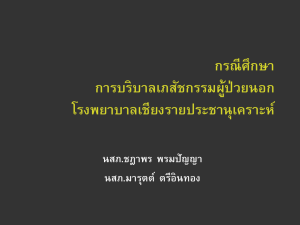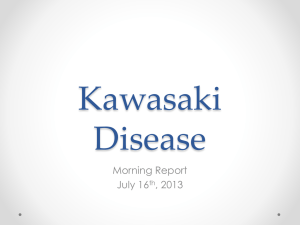KD outline 2006
advertisement
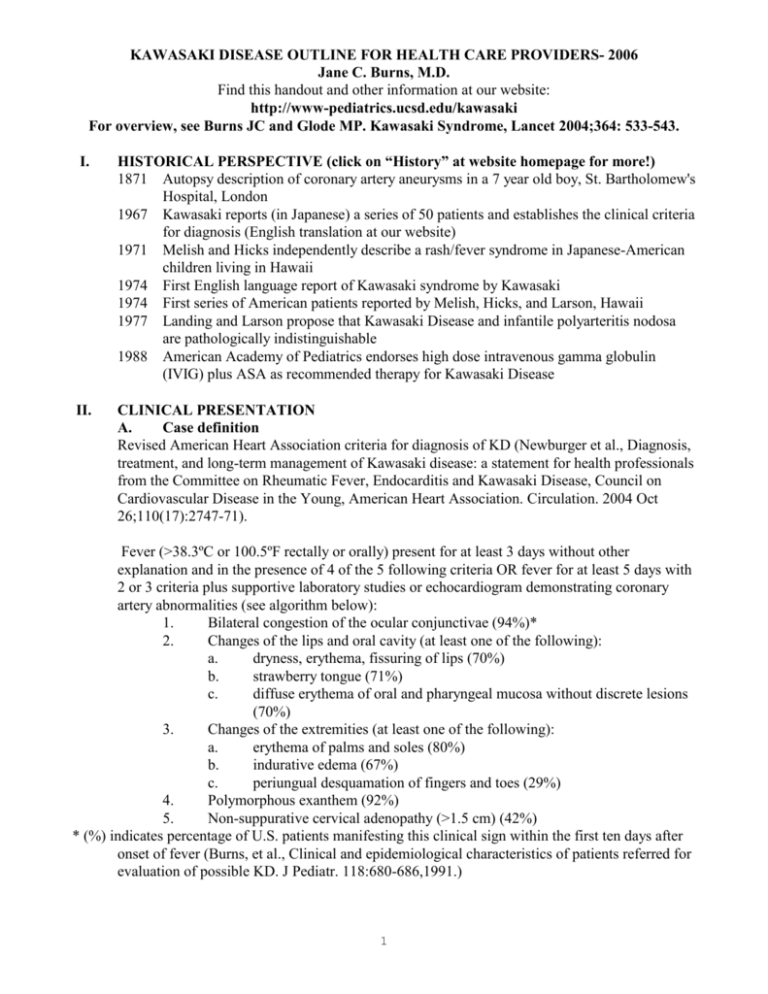
KAWASAKI DISEASE OUTLINE FOR HEALTH CARE PROVIDERS- 2006 Jane C. Burns, M.D. Find this handout and other information at our website: http://www-pediatrics.ucsd.edu/kawasaki For overview, see Burns JC and Glode MP. Kawasaki Syndrome, Lancet 2004;364: 533-543. I. HISTORICAL PERSPECTIVE (click on “History” at website homepage for more!) 1871 Autopsy description of coronary artery aneurysms in a 7 year old boy, St. Bartholomew's Hospital, London 1967 Kawasaki reports (in Japanese) a series of 50 patients and establishes the clinical criteria for diagnosis (English translation at our website) 1971 Melish and Hicks independently describe a rash/fever syndrome in Japanese-American children living in Hawaii 1974 First English language report of Kawasaki syndrome by Kawasaki 1974 First series of American patients reported by Melish, Hicks, and Larson, Hawaii 1977 Landing and Larson propose that Kawasaki Disease and infantile polyarteritis nodosa are pathologically indistinguishable 1988 American Academy of Pediatrics endorses high dose intravenous gamma globulin (IVIG) plus ASA as recommended therapy for Kawasaki Disease II. CLINICAL PRESENTATION A. Case definition Revised American Heart Association criteria for diagnosis of KD (Newburger et al., Diagnosis, treatment, and long-term management of Kawasaki disease: a statement for health professionals from the Committee on Rheumatic Fever, Endocarditis and Kawasaki Disease, Council on Cardiovascular Disease in the Young, American Heart Association. Circulation. 2004 Oct 26;110(17):2747-71). Fever (>38.3ºC or 100.5ºF rectally or orally) present for at least 3 days without other explanation and in the presence of 4 of the 5 following criteria OR fever for at least 5 days with 2 or 3 criteria plus supportive laboratory studies or echocardiogram demonstrating coronary artery abnormalities (see algorithm below): 1. Bilateral congestion of the ocular conjunctivae (94%)* 2. Changes of the lips and oral cavity (at least one of the following): a. dryness, erythema, fissuring of lips (70%) b. strawberry tongue (71%) c. diffuse erythema of oral and pharyngeal mucosa without discrete lesions (70%) 3. Changes of the extremities (at least one of the following): a. erythema of palms and soles (80%) b. indurative edema (67%) c. periungual desquamation of fingers and toes (29%) 4. Polymorphous exanthem (92%) 5. Non-suppurative cervical adenopathy (>1.5 cm) (42%) * (%) indicates percentage of U.S. patients manifesting this clinical sign within the first ten days after onset of fever (Burns, et al., Clinical and epidemiological characteristics of patients referred for evaluation of possible KD. J Pediatr. 118:680-686,1991.) 1 Figure 1. Evaluation of suspected incomplete Kawasaki disease. (1) In the absence of gold standard for diagnosis, this algorithm cannot be evidence based but rather represents the informed opinion of the expert committee. Consultation with an expert should be sought anytime assistance is needed. (2) Infants 6 months old on day 7 of fever without other explanation should undergo laboratory testing and, if evidence of systemic inflammation is found, an echocardiogram, even if the infants have no clinical criteria. (3) Patient characteristics suggesting Kawasaki disease are listed in Table 1. Characteristics suggesting disease other than Kawasaki disease include exudative conjunctivitis, exudative pharyngitis, discrete intraoral lesions, bullous or vesicular rash, or generalized adenopathy. Consider alternative diagnoses (see Table 2). (4) Supplemental laboratory criteria include albumin 3.0 g/dL, anemia for age, elevation of alanine aminotransferase, platelets after 7 d 450 000/mm3, white blood cell count 15 000/mm3, and urine 10 white blood cells/high-power field. (5) Can treat before performing echocardiogram. (6) Echocardiogram is considered positive for purposes of this algorithm if any of 3 conditions are met: z score of LAD or RCA 2.5, coronary arteries meet Japanese Ministry of Health criteria for aneurysms, or 3 other suggestive features exist, including perivascular brightness, lack of tapering, decreased LV function, mitral regurgitation, pericardial effusion, or z scores in LAD or RCA of 2–2.5. (7) If the echocardiogram is positive, treatment should be given to children within 10 d of fever onset and those beyond day 10 with clinical and laboratory signs (CRP, ESR) of ongoing inflammation. (8) Typical peeling begins under nail bed of fingers and then toes. (From AHA Guidelines, Newburger et al.,2004). 2 Table 1. Differential diagnosis of a red eye in the face of prolonged fever and rash in the pediatric patient (adapted from Smith LS, Newburger JW, Burns JC: Kawasaki Disease and the Eye. Ped. Inf. Dis. J. 8:116-118, 1989.) 1. Kawasaki disease* 2. Streptococcal and staphylococcal toxin-mediated diseases (e.g. scarlet fever, toxic shock syndrome) 3. Adenovirus, enterovirus, measles* 4. Drug reactions, Stevens-Johnson syn.* 5. Leptospirosis* 6. Yersinia pseudotuberculosis infection 7. Rickettsial infection 8. Reiter=s syndrome* 9. Inflammatory bowel disease* 10. Post-infectious immune complex disease* (e.g. (post-meningococcemia) 11. Sarcoidosis* 12. Systemic lupus erythematosus* 13. Behcet=s syndrome* *May have evidence of anterior uveitis by slit lamp examination B. Clinical Pearls 1. Rash - never vesicular or bullous; can be accentuated in perineum where it may be associated with local desquamation; can be micropustular with ~1mm pustules 2. Conjunctival injection - not associated with exudate; + limbal sparing; anterior uveitis present by slit lamp examination in 83% of patients if examined during the first week of illness. The finding of anterior uveitis strongly supports the diagnosis of KD as it is not known to be associated with other fever/rash illnesses in infancy and childhood (viral illnesses, streptococcal and staphylococcal toxin-mediated illness, allergic drug reactions, or systemic onset JRA). 3. Cervical adenopathy - at least one cervical node >1.5 cm. was present in only 42% of KD patients in one U.S. series (Burns, et al., 1991). Generalized adenopathy is never a feature of KD. 4. Difficult diagnosis - KD may be difficult to diagnose in infants less than 6 months of age due to incomplete presentations. KD should be considered in any young infant with prolonged fever (>1 week) in whom no other 3 C. D. III. cause can be found. Echocardiography and slit lamp examination for anterior uveitis may be helpful in the evaluation of such patients. 5. Adolescent patients with KD are frequently misdiagnosed because the physician does not consider KD in this age group. Associated Clinical Features 1. Urethritis associated with sterile pyuria 2. Arthralgia and arthritis - may occur in 35% of patients; 2 distinct patterns described by Hicks - small joint arthritis which occurs early in acute phase and large weight-bearing joint involvement in 2nd-3rd week of illness (Hicks and Melish, 1986) 3. Aseptic meningitis - usually associated with mild CSF pleocytosis and a normal CSF glucose and protein (Dengler et al., Cerebrospinal fluid profile in patients with acute Kawasaki Disease. Ped. Inf. Dis. J.17:478481, 1998.) 4. Diarrhea and vomiting 5. Hydrops of the gall bladder with or without obstructive jaundice. 6. Cardiac findings - CHF, myocarditis, pericardial effusion, arrhythmias, mitral insufficiency, acute myocardial infarction. 7. Sensorineural hearing loss - transient high frequency loss or permanent loss Cardiac Complications 1. Mortality - <1%, all cases due to cardiac complications. 2. Incidence of coronary artery aneurysms varies with age and sex. Overall, 15-25% incidence in untreated patients (based on large series from U.S. and Japan). 3. Resolution of aneurysms varies with age of onset of disease and size and shape of aneurysm N.B. "Resolution of aneurysms" does not mean return of vessel to normal. Risk of accelerated atherosclerotic changes in previously damaged vessels unknown but of concern. (Sasguri and Kato, 1982; Dhillon et al., 1996; Mitani et al., 1997 ) 4. Myocardial infarction - Japanese series of 195 patients with MI following KD: 73% within 1 year of disease onset. All but three patients were asymptomatic prior to their MI; 63% of the infarction episodes were clinically silent. (Kato et al., 1986) Mortality: 33% in patients with symptomatic MI; 4% in patients with silent MI ETIOLOGY/EPIDEMIOLOGY/GENETICS A. The following factors suggest that KD is caused by an infectious agent: 1. Seasonal incidence with peak in winter/spring (Burns et al. Seasonality and temporal clustering of Kawasaki Syndrome in Japan, 1987-2000. Epidemiology 2005;16:220-225. 2. Geographic clustering of cases/outbreaks - no documented person-toperson spread 3. Age distribution - peak incidence in toddler age group, rare reports of disease in adults and neonates. Suggests occurrence of asymptomatic infection with development protective Ab 4 D. IV. 4. Clinical syndrome mimics other infectious diseases B. Male predominance with male:female ratio of 1.6:1 C. Possible association with antecedent viral upper respiratory infection (Hawaii) (Dean et al., 1982), exposure to freshly cleaned carpet (Denver) (Patriarca et al., 1982), and residence near a body of standing water (Rausch et al., 1987). Susceptibility to KD influenced by IL-4 and chemokine gene polymorphisms (Burns et al. Family-based association analysis of genes in inflammatory and cardiovascular pathways implicates IL-4 in Kawasaki Disease. Genes and Immunity 2005;6:438-444; Burns et al., Genetic variations in the receptor-ligand pair, CCR5 and CCL3L1, are important determinants of susceptibility to Kawasaki disease. J Infect Dis. 2005;192:344-349.) LABORATORY FINDINGS (Burns et al., 1991)) A. Hematology 1. Leukocytosis with neutrophil predominance and left shift common in acute phase; thrombocytosis peaks in the 3-4th week; normocytic, normochromic anemia present early and persists until inflammatory process begins to subside, reticulocyte count low. B. Urine cytology 1. Mononuclear cells with cytoplasmic inclusions are abundant in the urine early in the disease; these cells are not detected by dipstick methods for "WBC" which detect leukocyte esterase present only in neutrophils. Cells apparently originate in the urethra and a catheterized specimen may not contain these cells. C. Coagulation 1. Marked hypercoagulability early in illness associated with increased platelet turnover and depletion of fibrinolytic system (Burns et al., 1984) 2. 10% of patients have low-grade disseminated intravascular coagulation D. Acute Phase Reactants 1. Elevated erythrocyte sedimentation rate (ESR) reflects increased hepatic synthesis of fibrinogen and other acute phase reactants; persists beyond the acute febrile period and gradually returns to normal over 1-2 months. a. clinical pearl - the persistence of an elevated ESR after the fever has subsided can help to distinguish KD from other infectious rash/fever illnesses b. Low ESR coupled with low/normal platelet count should prompt consideration of low-grade DIC; check coagulation panel 2. C-reactive protein (CRP) elevated during the acute illness; CRP elevated early in illness whereas peak in ESR occurs toward end of 1st week of fever. 3. Treatment with IV gammaglobulin falsely elevates the ESR E. Chemistry 1. Elevated liver transaminases (2-3 x normal) common in acute phase, may also have cholestatic profile with elevated bilirubin, γ-GGT, and alkaline phosphatase; GGT is elevated in over 60% of patients (Ting et al., Elevated gamma-glutamyl transferase concentrations in patients with acute Kawasaki disease. Ped. Inf. Dis. J. 17:431-432, 1998.) 2. Hypoalbuminemia common F. Immunology 5 1. 2. 3. 4. 5. V. Marked activation of circulating monocyte/macrophages Dramatic B cell polyclonal activation Increased serum IgA and IgM with low-normal IgG T cell lymphopenia Increased pro-inflammatory cytokines and chemokines including TNFα , IL-2, IL-6, and IL-8 6. Increased anti-inflammatory cytokines including IL-10 G. Cardiac Evaluation 1. EKG usually normal, but may rarely reflect strain, ischemia, and/or infarct 2. 2-D echo has 100% sensitivity and about 90% specificity in skilled hands for detecting aneurysms of the proximal coronary arteries; aneurysms may first be seen from 7-21 days post-onset of fever. 3. Evaluation of coronary arteries should use z score criteria corrected for body surface area to define dilatation of vessels (de Zori et al., 1998) MANAGEMENT/THERAPY A. Initial Evaluation 1. All patients should have a baseline cardiac evaluation including EKG and echocardiogram as soon as the diagnosis is suspected and before administration of IVGG, if possible 2. Laboratory studies should include a CBC with differential and platelet count, ESR, CRP, U/A, ALT, albumin, and GGT 3. Appropriate testing to exclude other diagnostic possibilities as indicated clinically: blood culture, ASO titer, streptozyme, and throat cx for Group A strep; additional cultures (bacterial, viral); serologies (leptospirosis, EBV, rickettsia, measles, rubella) B. Follow-up Evaluation 1. Echocardiogram 7-10 days after discharge from hospital (usually in 2nd3rd week after fever onset) and at 2-3 months. No further imaging studies for AHA Risk Level I or II (dilatation resolved). 2. MR angiogram, CT angiogram, or cardiac catheterization indicated at one year in patients with aneurysm or ectasia by echocardiogram. Need to define anatomy, look for stenosis, and check for distal coronary aneurysms and aneurysms in other vessels (e.g. brachial, internal iliac arteries) 3. AHA recommendations for long-term follow-up in patients with normal cardiac evaluation a. repeat EKG at every 3-5 years and lipid profile determination at least one year after disease onset 4. Long-term follow-up for patients with abnormal coronary arteries must be individualized and should be performed by an experienced pediatric cardiologist C. Therapy 1. High dose IV gammaglobulin is the treatment of choice for all patients with KD CURRENTLY RECOMMENDED PROTOCOL: 2 g/kg single infusion 97% effective in prevention of aneurysms (Newburger et al., 1991) and 85% effective in resolving fever a. high dose ASA (80-100 mg/kg/day divided q 6h) should be given initially in conjunction with IVIG and then reduced to low dose 6 2. 3. 4. ASA (3-5 mg/kg/day) and continued until cardiac evaluation completed (approximately 1-2 months after onset of disease) b. mechanism of action of IVIG?? i) ? non-specific modulator/suppressor of immune-mediated inflammatory response: IgG dimers engage Fc receptors ii) ? specific anti-agent, antitoxin, anti-cytokine, or antiidiotype antibodies iii) ? removal of activated complement fragments d. risks of IVGG: no known transmission of HIV or Hepatitis B virus; previous problem with transmission of Hepatitis C virus Treatment of 15% of patients who fail to respond to first IVIG infusion: Clinical trial of inhibitor of TNF-α, (infliximab) vs. 2nd IVIG infusion currently under investigation (Burns JC, et al. Infliximab treatment for refractory Kawasaki syndrome. J Pediatr. 2005;146:662-667.) Administration of live virus vaccines (MMR, VZV) should be delayed 12 months after IVIG administration Treatment of patients with aneurysms a. long-term use of antiplatelet agents (low dose ASA, clopidogrel, ticlopidine) recommended but not proven to prevent long-term complications, i.e., thrombosis, atherosclerosis b. systemic anticoagulation with low-molecular weight heparin or coumadin may prevent thrombosis in patients with giant aneurysms (>8mm) and in selected other patients c. catheter intervention with angioplasty, rotoablation, and stenting and surgical intervention with internal mammary artery bypass grafts and cardiac transplantation reserved for patients with severe coronary artery damage and ischemia (reviewed in Newburger et al., 2004) 7

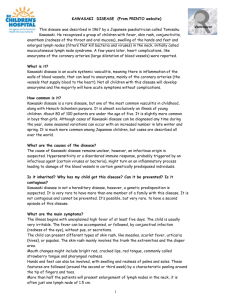
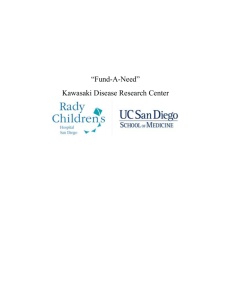

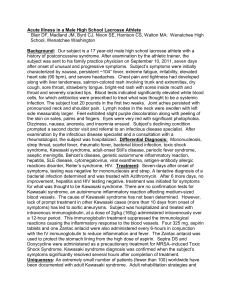
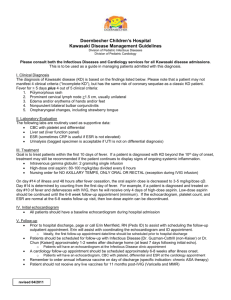
![Text S1. Definition of Kawasaki disease. Revision 3 [1] A case that](http://s3.studylib.net/store/data/007393039_1-17c01a2c264d14b096d94d62e7027753-300x300.png)
